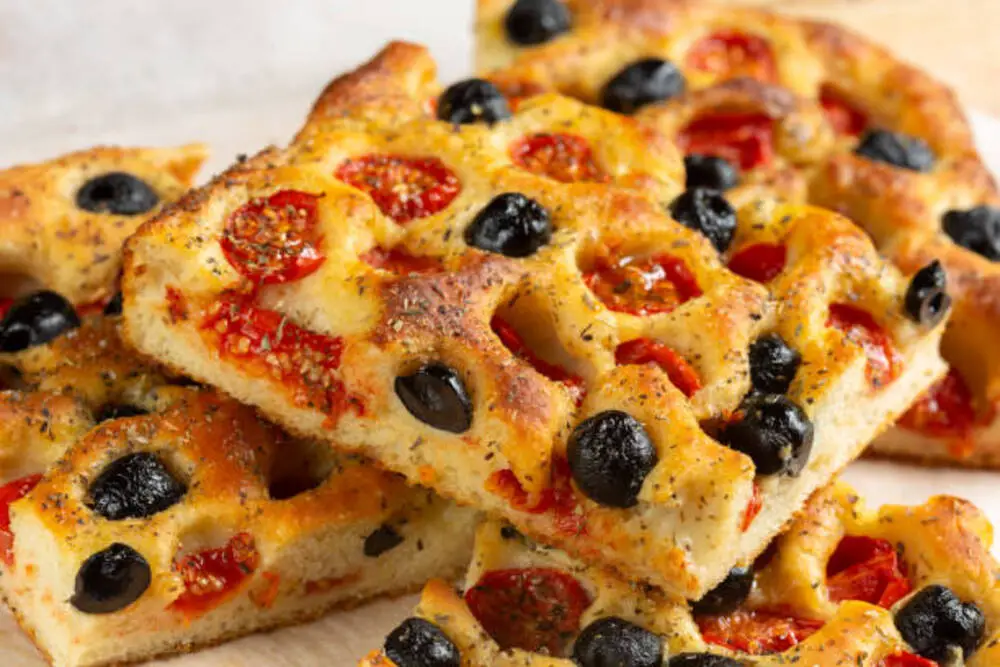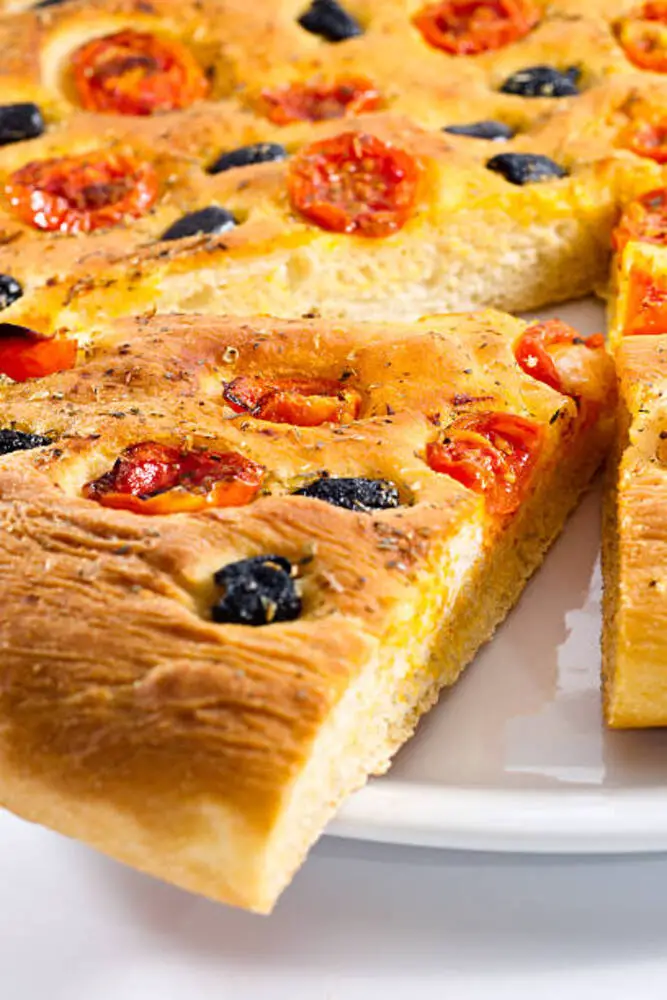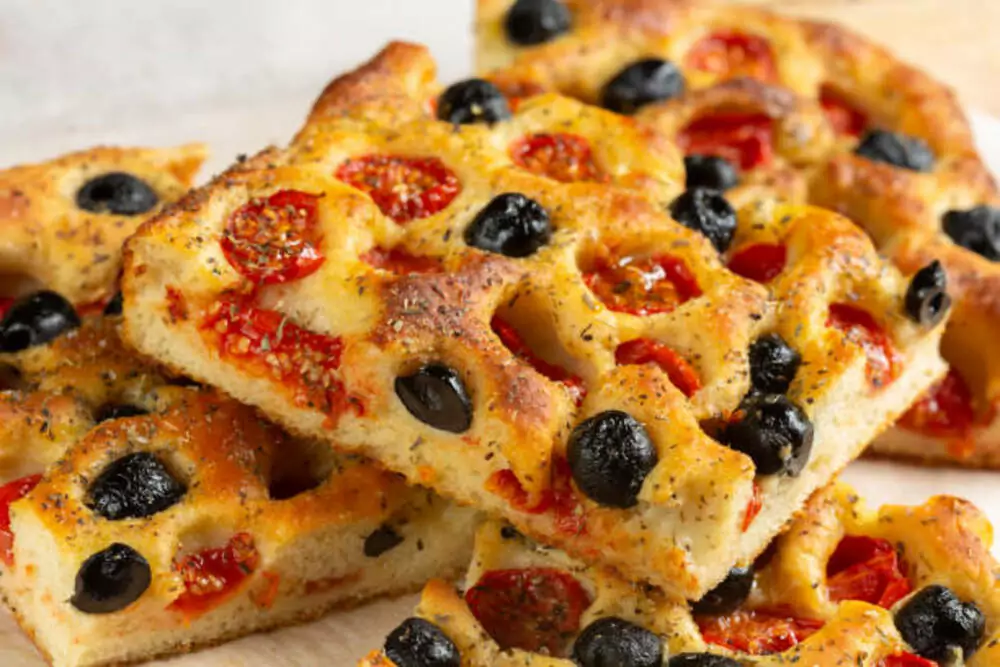Sourdough Focaccia is a delightful and versatile bread, perfect for any occasion. With its crispy exterior and soft, airy interior, it’s a crowd-pleaser that can be customized with a variety of toppings. This recipe will guide you through the process of making your own delicious sourdough focaccia at home, ensuring a flavorful and satisfying result every time.

Ingredients Overview
For this recipe, you’ll need 459g of water, 115g of ripe sourdough starter, 423g of all-purpose flour, 181g of high-protein bread flour, 11g of salt, and 12g of extra virgin olive oil. Using high-quality ingredients is crucial to achieving the best flavor and texture in your focaccia. Fresh, high-protein flour helps create a light and airy crumb, while good-quality olive oil adds a rich, fruity flavor.
If you don’t have high-protein bread flour, you can substitute it with more all-purpose flour, though the texture may be slightly different. Additionally, if you prefer a different type of oil, such as avocado or grapeseed, feel free to experiment. Just be mindful that the flavor profile of the focaccia will change accordingly.
Step-by-Step Instructions
Mixing the Dough
To start, you can mix the dough by hand or with a stand mixer. In the bowl of a stand mixer fitted with a dough hook, combine both flours, water, salt, and the ripe sourdough starter. Reserve the olive oil for later. Begin mixing on low speed for 1 to 2 minutes until everything is just combined. Then, increase the speed to medium and continue mixing for another 5 minutes until the dough strengthens and forms around the hook. Allow the dough to rest for 10 minutes in the mixing bowl.
If you’re mixing by hand, combine the ingredients in a large bowl and mix until a shaggy dough forms. Let it rest for a few minutes, then knead for about 10 minutes until the dough is smooth and elastic. The resting period helps the dough develop gluten, making it easier to knead and shape.
After resting, turn the mixer back on to low speed and gradually drizzle in the olive oil while mixing. Once the oil is fully incorporated, increase to medium speed for an additional 1 to 2 minutes until the dough comes together again. Transfer the dough to a container for bulk fermentation and cover it.
Bulk Fermentation
Bulk fermentation is a crucial step in developing the dough’s flavor and structure. Perform 4 sets of stretch and folds at 30-minute intervals, starting 30 minutes after the bulk fermentation begins. To do this, wet your hands to prevent sticking, then gently lift one side of the dough and fold it over itself. Rotate the container and repeat on all four sides. This process helps to build strength and elasticity in the dough.
Proofing the Dough
Generously oil the inside of a 9×13″ rectangular pan or two 10″ round baking pans. Carefully transfer the dough from the bulk fermentation container directly into the oiled pan(s). If you’re using two round pans, divide the dough on a work surface before placing it in the pans. The dough will proof in the pan(s) for 4 hours.
During the first hour, every 30 minutes, uncover the pan and gently stretch the dough with wet hands toward the edges to help it fill the pan. The dough will naturally expand over the proofing period, so minimal spreading is required. After the first hour, cover the pan and let the dough proof for the remaining 3 hours. About 30 minutes before the proofing period ends, preheat your oven to 450°F (230°C) with a rack positioned in the lower third.
Topping and Baking
Once your oven is preheated, use wet fingers to dimple the surface of the dough all over. This creates those characteristic focaccia pockets that hold the olive oil and toppings. Generously drizzle olive oil over the top, ensuring it is well covered. Sprinkle with chopped herbs and coarse sea salt. Popular herbs include rosemary, thyme, and oregano, but feel free to get creative with your favorites.
Bake the focaccia for about 30 minutes, or until it is golden brown on both the top and bottom. Baking at a high temperature helps achieve a crispy crust while keeping the inside tender and moist. Let it cool in the pan for a few minutes before transferring it to a cooling rack. This focaccia is delightful straight from the oven and is best enjoyed on the day it is baked.
Recipe Tips & Frequently Asked Questions
Ensuring your sourdough starter is ripe: Use your starter when it’s at its peak activity for the best rise and flavor.
Adjusting the recipe for different climates: In humid environments, reduce the water slightly; in dry climates, you may need a bit more.
Common mistakes to avoid and troubleshooting: Ensure proper fermentation time and avoid overmixing the dough to maintain the desired texture.
How can I tell if my dough is properly fermented? Look for a dough that has doubled in size and has a slightly domed surface.
Can I use a different type of flour? Yes, but it may alter the texture slightly. Experiment to find your preferred combination.
How should I store leftover focaccia? Wrap it tightly in plastic wrap and store at room temperature for up to two days.
Can I freeze the dough or the baked focaccia? Yes, both can be frozen. Thaw the dough in the fridge overnight or reheat the baked focaccia in the oven.
What to Serve with this Recipe
Sourdough focaccia pairs beautifully with a variety of dishes. Serve it alongside a hearty soup, such as minestrone or tomato basil, to soak up the delicious broth. It’s also a fantastic accompaniment to fresh salads, like a classic Caesar or a mixed green salad with balsamic vinaigrette. For a main course, consider serving it with roasted chicken, grilled vegetables, or a charcuterie board for a delightful combination of flavors.
For beverages, a crisp white wine, such as Sauvignon Blanc or Pinot Grigio, complements the herbaceous notes of the focaccia. For a non-alcoholic option, try pairing it with sparkling water infused with lemon or lime for a refreshing contrast.
For special occasions, get creative with your presentation. Cut the focaccia into small squares and serve it as an appetizer with a variety of dips, such as olive tapenade, hummus, or a creamy artichoke dip. Your guests will be impressed by the delicious and versatile bread.
Variations and Customizations
One of the best aspects of focaccia is its versatility. You can customize the toppings to suit your taste. Consider adding caramelized onions, sun-dried tomatoes, or thinly sliced olives for an extra burst of flavor. For a cheesy twist, sprinkle grated Parmesan or mozzarella over the top before baking.
If you have a sweet tooth, try making a sweet version of focaccia. Add a sprinkle of cinnamon and sugar, along with a handful of raisins or dried cranberries, before baking. This sweet focaccia is perfect for breakfast or dessert.
Adjusting the recipe for different pan sizes is also easy. For a thicker focaccia, use a smaller pan and allow for a longer proofing time. For a thinner, crispier focaccia, spread the dough more thinly in a larger pan and reduce the baking time slightly. Experiment with different sizes and shapes to find your perfect focaccia.
Making sourdough focaccia at home is a rewarding experience that yields delicious results. With its crispy crust and tender crumb, this versatile bread is sure to become a favorite in your household. Try out this recipe and share your creations with friends and family. Enjoy the process and savor the delightful flavors of homemade sourdough focaccia.

Ingredients:
459g water
115g ripe sourdough starter
423g all-purpose flour
181g high-protein bread flour
11g salt
12g extra virgin olive oil
Instructions:
Mix (9:00 a.m.)
You can mix this dough by hand or use a stand mixer. In the bowl of a stand mixer equipped with a dough hook, combine both flours, water, salt, and the ripe sourdough starter, reserving the olive oil for later. Start mixing on low speed (speed 1) for 1 to 2 minutes until everything is just combined. Increase the speed to medium (speed 2) and mix for another 5 minutes until the dough becomes stronger and gathers around the hook. Allow the dough to rest in the bowl for 10 minutes. Turn the mixer back on to speed 1 and gradually add the olive oil while mixing. Once the olive oil is fully incorporated, increase to speed 2 for an additional 1 to 2 minutes until the dough is cohesive again. Transfer the dough to a container for bulk fermentation and cover it.
Bulk Fermentation (9:15 a.m. to 11:15 a.m.)
Perform 4 sets of stretch and folds at 30-minute intervals, starting 30 minutes after the bulk fermentation begins.
Proof (11:15 a.m. to 3:15 p.m.)
Generously oil the inside of a 9×13″ rectangular pan or two 10″ round baking pans. Gently transfer the dough from the bulk fermentation container directly into the oiled pan(s). If using two round pans, divide the dough on a work surface before placing it in the pans. The dough will proof in the pan(s) for 4 hours. During the first hour, every 30 minutes, uncover the pan and gently stretch the dough with wet hands toward the edges to help it fill the pan. The dough will naturally expand over the proofing period, so minimal spreading is required. After the first hour, cover the pan and let the dough proof for the remaining 3 hours. About 30 minutes before the proofing period ends, preheat your oven to 450°F (230°C) with a rack positioned in the lower third.
Top & Bake (3:15 p.m.)
Once your oven is preheated, use wet fingers to dimple the surface of the dough all over. Generously drizzle olive oil over the top, ensuring it is well covered. Sprinkle with chopped herbs and coarse sea salt. Bake the focaccia for about 30 minutes, or until it is golden brown on both the top and bottom. Let it cool in the pan for a few minutes before transferring it to a cooling rack. This focaccia is delightful straight from the oven and is best enjoyed on the day it is baked.

Sourdough Focaccia Recipe
Ingredients
- 459 g water
- 115 g ripe sourdough starter
- 423 g all-purpose flour
- 181 g high-protein bread flour
- 11 g salt
- 12 g extra virgin olive oil
Instructions
Mix (9:00 a.m.)
- You can mix this dough by hand or use a stand mixer. In the bowl of a stand mixer equipped with a dough hook, combine both flours, water, salt, and the ripe sourdough starter, reserving the olive oil for later. Start mixing on low speed (speed 1) for 1 to 2 minutes until everything is just combined. Increase the speed to medium (speed 2) and mix for another 5 minutes until the dough becomes stronger and gathers around the hook. Allow the dough to rest in the bowl for 10 minutes. Turn the mixer back on to speed 1 and gradually add the olive oil while mixing. Once the olive oil is fully incorporated, increase to speed 2 for an additional 1 to 2 minutes until the dough is cohesive again. Transfer the dough to a container for bulk fermentation and cover it.
Bulk Fermentation (9:15 a.m. to 11:15 a.m.)
- Perform 4 sets of stretch and folds at 30-minute intervals, starting 30 minutes after the bulk fermentation begins.
Proof (11:15 a.m. to 3:15 p.m.)
- Generously oil the inside of a 9×13″ rectangular pan or two 10″ round baking pans. Gently transfer the dough from the bulk fermentation container directly into the oiled pan(s). If using two round pans, divide the dough on a work surface before placing it in the pans. The dough will proof in the pan(s) for 4 hours. During the first hour, every 30 minutes, uncover the pan and gently stretch the dough with wet hands toward the edges to help it fill the pan. The dough will naturally expand over the proofing period, so minimal spreading is required. After the first hour, cover the pan and let the dough proof for the remaining 3 hours. About 30 minutes before the proofing period ends, preheat your oven to 450°F (230°C) with a rack positioned in the lower third.
Top & Bake (3:15 p.m.)
- Once your oven is preheated, use wet fingers to dimple the surface of the dough all over. Generously drizzle olive oil over the top, ensuring it is well covered. Sprinkle with chopped herbs and coarse sea salt. Bake the focaccia for about 30 minutes, or until it is golden brown on both the top and bottom. Let it cool in the pan for a few minutes before transferring it to a cooling rack. This focaccia is delightful straight from the oven and is best enjoyed on the day it is baked.


